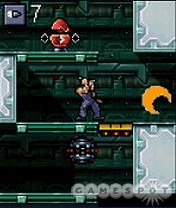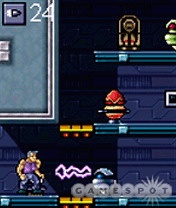A unique action puzzler, Impossible Mission is probably best known for its Atari 7800 and Commodore 64 iterations. In the game, you play as the special agent responsible for bringing the loathsome Dr. Elevferii Fyodor Ostrov (alias Elvin Atombender) to justice, before he has a chance to nuke the world. The graphics in Mforma's port have been much improved over those of its predecessors, although your character now looks like a GI Joe figurine, rather than a lean, unitard-sporting operative of the future. The gameplay remains unchanged and is just as interesting a mix of quick-twitch action and spatial puzzling as ever. While it's not the most accessible game, Impossible Mission is poised to delight a new generation of players.

In Impossible Mission, your goal is to complete four sliding puzzles, the pieces of which are scattered all around Dr. Atombender's sprawling lab. These puzzles represent the hacked launch codes the crazed engineer will be using to send four of the world's nukes into populated areas. To find these chips, you'll have to check behind digital furniture that's usually well guarded by a legion of robot slaves. Dr. Atombender's house is as inconstant and capricious as he is; every time you begin a game, its rooms will be rearranged. This adds a lot of replay value to an already challenging game. When you collect a puzzle piece, it will show up on one of your puzzle screens, found on your pocket computer. Strangely enough, your generic PDA of yore seems to have been replaced by a Tapwave Zodiac. One wonders if this is an extension of the in-game advertising now cropping up on other platforms.
Most of the game's challenges lie in devising clever ways to evade patrolling robots. You can study their patterned attacks and leap over them, use them to destroy one another, or shoot them outright. You've got only a limited number of bullets, however, meant to act as "get out of jail free" cards. Additionally, you may come across computer-terminal access codes, allowing you to shut down droids or to reset a room's hovering elevators, in case you become trapped. Some rooms might require quick reflexes, but careful planning is paramount.
Interestingly enough, you don't have extra lives in Impossible Mission--at least not in the conventional sense. Instead, you have six hours to stop Dr. Atombender, and each death detracts from that total time. Computer accesses and attempts to solve the launch-code puzzles also hasten the countdown. Even though it's possible to die a dozen times and still fare well, Impossible Mission is quite difficult to complete, given the preponderance of obstacles in your path and the draconic ammunition restrictions.

This version of Impossible Mission regrettably doesn't begin with Dr. Atombender's famous greeting, "Another visitor. Stay awhile. Stay...FOREVER!" In fact, apart from an opening tune and some gunshot sound effects, you really won't encounter much audio in this game. The graphics look just fine on the LG VX7000, however, despite the aforementioned stylistic change to the protagonist. All ambulatory robots animate well and appear appropriately menacing.
Impossible Mission's learning curve may be a bit steep, especially for the casual mobile gamer, who may have missed this game in the mid-'80s. This doesn't have the retro pull of a Pac-Man or a Galaga; it's a bit of an esoteric choice, really. Impossible Mission's not quite a puzzle game, nor an action title, which might alienate the dedicated fans of either genre. That said, this is a game that grows on you as you play it. If you're willing to invest the time, Impossible Mission will reward you proportionately.